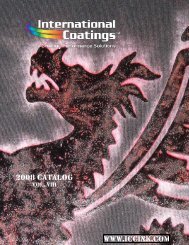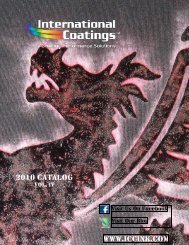2008 CATALOG WWW.ICCINK.COM
2008 CATALOG WWW.ICCINK.COM
2008 CATALOG WWW.ICCINK.COM
Create successful ePaper yourself
Turn your PDF publications into a flip-book with our unique Google optimized e-Paper software.
HOT PEEL OR HOT SPLIT TRANSFERS<br />
TRANSFER PRODUCTS<br />
Hot peel and hot split refer to transfers where the transfer paper is removed immediately after application in<br />
the transfer press. These terms are often used interchangeably to describe these inks and/or transfers. Hot split<br />
transfers split the ink film between the paper and the fabric applied to upon the application of heat and pressure. A<br />
portion of the ink remains on the transfer paper and the majority of the ink melts into the fabric. This splitting of the<br />
ink film produces a very soft, breathable print when using standard opacity inks. Some types of transfer inks melt<br />
almost entirely into the fabric being applied to and leave very little, if any, ink on the paper. The paper and/or the<br />
ink used, along with application time, temperature and pressure of the heat seal machine, can all govern whether the<br />
ink melts entirely into the fabric or not. Hot peel transfers, where almost the entire ink film is released, may not be<br />
quite as soft and breathable as hot split transfers may. The difference in products may be too slight to notice in some<br />
applications.<br />
The papers recommended for printing hot split or hot peel transfers range from non-coated papers to<br />
specially coated papers. Both types of papers perform well, but the specialty-coated papers are usually more<br />
forgiving to the novice transfer printer. The better release of the coated paper, as compared to a non-coated paper,<br />
allows for a little over gelation of the inks. Gelation is the term used for a partial fusing (surface dry) of the inks<br />
when printed. Over gelation of the inks, when printing transfers, can cause poor release, spotty transfers, or poor<br />
adhesion. To print transfers, the inks must be gelled between each color, not printed wet on wet as in direct printing.<br />
Gelation temperatures range from 225°F to 275°F (107°C to 135°C) depending on the ink film thickness, and the<br />
ink being used. Properly gelled ink is dry to the touch, but should break apart easily if removed from the paper. If<br />
ink is severely under gelled and stored before application, the plasticizer (an ingredient in the ink) may exude from<br />
the ink. This may be noticed as a clear uneven border around the outside of the print on the paper. If this happens,<br />
the transfer is now missing an ingredient it needs for proper adhesion and fusing. Adding too much reducer to the<br />
transfer ink may hasten this problem. The final fusing of the inks is accomplished when the transfer is applied to the<br />
garment.<br />
NOTE:<br />
Fusing is the proper term for drying plastisol inks. Curing is a generally accepted term when<br />
referring to the drying of plastisol inks, but is really what happens to most water or solvent based inks<br />
when heated or catalyzed.<br />
It is important to use papers designed for transfer printing, because they are usually more temperature stable<br />
than conventional bond papers. This is very important when printing hot split, multicolor transfers. Papers tend to<br />
shrink when heat is applied to them. Since hot split transfers need to be butt registered, (colors touch or almost<br />
touch each other but do not overlap) too much shrinkage leads to poor registration. Poor registration leads to<br />
noticeable gaps between colors in hot split transfers, or muddy looking colors where colors overlap. It is important<br />
to preheat transfer paper before printing multicolor transfers and to keep paper warm between colors until the job is<br />
finished. Many printers use hot boxes, which is a cabinet that is heated to 120°F to 130°F (49°C to 54°C), to store<br />
printed paper between colors and overnight.<br />
Printing hot split or hot peel inks is done with plastisol inks that have a lower melt point than standard<br />
plastisol inks. The lower melt point allows the inks to release or split quickly from the paper and to penetrate into<br />
the garment. This gives the inks a very soft hand and excellent durability. International Coatings has developed an<br />
120




